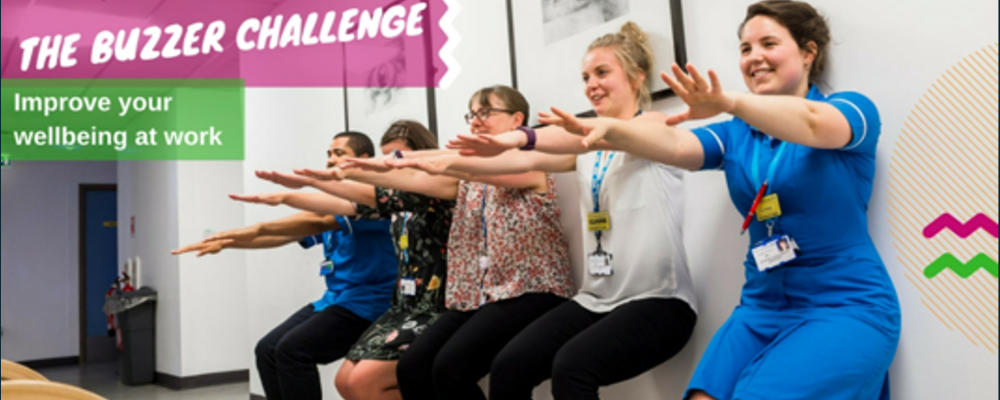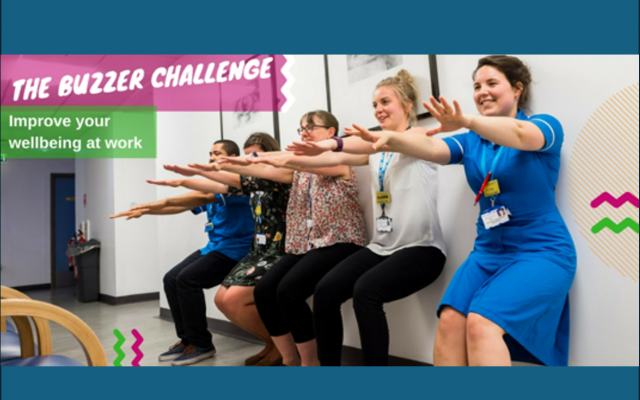University Hospitals Bristol and Weston
What is the name of your intervention?
The Buzzer Challenge
Which Health and Wellbeing area did you choose to focus on?
Musculoskeletal Health (MSK) and Physical activity
Why did you choose this area of focus for your staff?
To tackle sedentary behaviour. Insufficient physical activity is a key risk factor for diseases such as cardiovascular disease, cancer and diabetes. It is recommended that adults between the age of 18-64 do 150 minutes of moderate intensity physical activity throughout the week.
How would you describe your intervention?
The Buzzer Challenge is a practice to promote wellbeing in the workplace, including remote and hybrid working, in 3 different ways:
- Physical Activity – sedentary workers are encouraged to change their posture and to undertake physical activity.
- Mindfulness or ‘being in the moment’ – whereby colleagues focus attention on what is happening around them.
- Hydration – it is important to stay hydrated throughout the day to reduce headaches and keep energy levels high.
Colleagues/teams are provided with a buzzer (digital timer) which we advise to set for a duration of 50 minutes. When it sounds, participants may choose to undertake one or more of the above activities for approximately 1-2 minutes or for as long as they have available.
Upon joining, we provide a guidance pack with examples of stretches and mindfulness activities that could be undertaken.
How did you involve your staff in the intervention?
The original Buzzer Challenge focused solely on encouraging colleagues to take a break from the screen, change position/posture and undertake stretching or physical exercise. It was aimed at those in sedentary roles. Many of our patient-facing colleagues are on their feet for the majority of the day and so we co-designed the current initiative with clinical workers to also promote taking a break, staying hydrated and practicing brief mindfulness to make it more equitable and inclusive across the organisation.
How engaged were senior leaders in the intervention?
We use a range of communication tools to encourage participation including posters, the intranet, local and national wellbeing campaigns, and a wellbeing leaflet. Our Manual Handling leads and Physio department are best placed to refer or encourage use among those who may benefit the most such as colleagues experiencing MSK issues.
What has been the impact of this intervention for staff?
Teams are connecting together to boost personal health and wellbeing which is leading to improved relationships, productivity and sedentary behaviour.
How do you plan to continue with this intervention in the future?
We are currently using up a stock of buzzers, and moving forward, we will update our guidance to signpost participants to online timers thus making this a zero cost initiative. This initiative is inclusive to all colleagues, trainees and volunteers including colleagues with mobility issues and disabilities, and so it will remain a permanent element of the wellbeing offer. The guide is updated annually with experts from manual handling, ergonomics and physiotherapy.
What have you learned from developing this intervention?
Whilst this scheme centres primarily on physical health and wellbeing, colleagues report many benefits from undertaking the challenge as a team including strengthened relationships, morale, and a stronger sense of teamwork, cultivating a collaborative and supportive work culture.
Can you offer any advice to other organisations thinking about developing this kind of intervention?
This initiative is likely to be easily replicated by most employers who can ensure guidance reflects current best practice via national NHS guidance e.g. Better Health website. Electronic timers can be used on PC or devices in place of buzzers.


